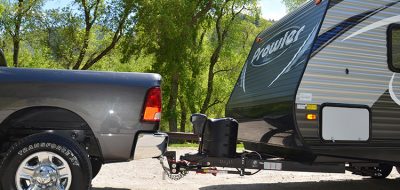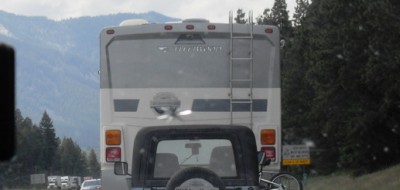In last week’s article I talked about what trailer sway is, and I ended the article by listing some of the most important items associated with trailer sways. This week we want to discuss some of the ways to help control trailer sway based on these causes for trailer sway.
If you missed last week’s article you can read it here: Trailer Sway; What It Is & How To Control It
The most important items associated with trailer sways are:
a) underinflated tires
b) improper weight distribution
c) improper hitch adjustments
d) no sway control
e) air pressure from transfer trucks passing
f) long downhill (descent)
g) lateral wind
h) towing speed
i) inadequate towing vehicle
j) overload conditions
k) hitch to tow vehicle rear axle distance
l) poor trailer design
m) Mismatched tow vehicle & trailer
n) Not completing trailer/tow vehicle checklist
So, to help avoid trailer sway, we recommend the following remedies:
a) Underinflated tires: Never leave on a trip without a tire inspection. If necessary, adjust the inflation pressure according to manufacturer recommendation. Always check and inflate tires when they are cold, before traveling more than one mile. Whenever you stop, inspect the tow vehicle and trailer conditions to include tire conditions. Check tire and hub temperature. In case of abnormally hot tires, or hubs there is something wrong. It may be bearing problems, underinflated tires or axle overloads. Try to identify the problem and correct it.
b) Improper weight distribution: When a trailer is manufactured it has very stringent weight balances. When you add after-market equipment or load the trailer try to balance the loaded weight from side-to-side and front to back. Bad lateral weight distribution can provoke sways and bad front to back weight distribution may generate up/down sways (Figure 3). Remember that the weight over the hitch ball should be 10 to 15% of the total loaded trailer weight. If the trailer has less than 10% tongue weight, load more weight towards the front of the trailer.
c) Hitch adjustments: Whenever using a weight distribution hitch it is extremely important that it is adjusted properly. If you are not sure how to adjust the hitch components take it to an authorized RV service center to have it adjusted.
d) No sway control: Sway controls help to limit the possibility of sway starting. Whenever possible have a sway control installed and make sure you understand how to adjust it.
e) Transfer trucks passing: Large trucks will pass you and you need to be prepared to make slight steering adjustments. When a truck passes you the main factor is the air displacement. The air pressure coming off of the truck pulls and pushes against the trailer. Try to observe wind intensity and direction, as well the air moisture which is the main villain. Humid air is heavier and increases lateral trailer displacements when being passed. Being aware of the situation is the best defense. Be prepared to make slight steering corrections, but do not over steer.
f) Long downhill (descent): When descending inclines reduce your speed, use a lower gear and apply weak vehicle braking, if necessary. Never do any abrupt vehicle braking. Continued use of the vehicle brakes can cause them to fade and not work properly. It may be necessary to manually activate the trailer brakes periodically to help slow down and/or to control sway. Slowly slide the brake lever over to activate the trailer brakes. It is important to manage a safe and manageable speed when descending inclines.
g) Lateral wind: Strong cross winds and windy days in general can be very dangerous when towing a trailer. It is better not to travel on very windy days. If you do experience lateral wind reduce your speed substantially and remain alert.
h) Towing speed: It is difficult to state what a safe speed is when towing a trailer. There are many variables, but not exceeding a speed of 60 miles/hour is a fair assessment. Use lower speeds if the traffic conditions are not normal (lateral winds, high humidity, rain, road conditions, downhill, etc).
i) Inadequate towing vehicle: Your tow vehicle may have enough power to move a trailer down the road, but what must be considered is whether the tow vehicles weight is adequate to support slowing down and to help prevent trailer sway. Every tow vehicle has weight limits and ratings. It is very important that these weight ratings are not exceeded. The farther you are from exceeding weight limits the safer it is for you and your family. A very general rule is the tow vehicles towing capacity should be capable of towing the Gross Vehicle Weight Rating (GVWR) of the trailer you are towing.
j) Overload: Never overload the tow vehicle or the trailer. Overloading tires, axles, Gross Vehicle Weight Ratings (GVWR) and Gross Combined Weight Ratings (GCWR) is extremely dangerous. Make sure all cargo loaded in the trailer is secured and that all weight added is properly distributed.
k) Hitch to tow vehicle rear axle distance: The distance from the tow vehicles rear axle to the hitch ball can contribute to sway. Less distance is always better. Ideally a longer wheelbase vehicle with a shorter overhang from the rear axle to the hitch ball is the best scenario. Basically it is associated with the lever effect. The distance between the rear axle and the hitch ball position may be understood as the lever length; and the longer the distance it is the higher the lateral forces applied to the axle position.
l) Poor trailer design: When there is too much weight behind the trailers axles causing the tongue weight to be less than 10% of the trailers weight it has a natural tendency to sway. In this case it will be necessary to load some of the weight towards the front of the trailer to increase tongue weight. Ideally tongue weight should be between 10 to 15% of the loaded trailer weight.
m) Mismatched tow vehicle & trailer: The tow vehicle and trailer need to be properly matched to make a safe towing system. An improperly matched tow vehicle and trailer can result in trailer sway. A tow vehicle without the proper towing capacity for the trailer it is towing, too light of a suspension system for the amount of tongue weight, too short of a wheelbase for the size of trailer can all contribute to trailer sway. The tow vehicle should be rated to tow the GVWR of the trailer you purchase.
n) Tow vehicle/trailer checklist: The tow vehicle and trailer must be in good mechanical condition to safely tow. The brakes and suspension on both the vehicle and trailer must be in proper operating condition. Prior to leaving on a trip inspect the suspension (shock absorbers, springs, bars, tires and other components on the trailer and the vehicle) and the operation and adjustment of the electric brakes for the trailer. Tires must be in good condition and inflated properly for the load. A checklist can help you remember what items to check.
Note: Adhering to these recommendations can help prevent sway from starting, but keep in mind there are no guarantees you will not encounter sway. If you do experience trailer sway you should gradually reduce speed, avoid using the vehicle brakes if possible, avoid harsh steering movements if possible and manually apply the trailer brakes by sliding the lever over on the electronic brake control to help bring the sway under control.
Everyone towing a trailer, even the most experienced, is a potential sway victim.When it comes to trailer sway caution is a necessity, but not always sufficient. Safety first! Being aware of what sway is and what you can do to help prevent it can help prepare you in the event your trailer starts to sway.
Note: Something else to keep in mind is wheel bearing and brake maintenance on your trailer. With routine wheel bearing and brake inspections and maintenance you can rest assured that not only will the bearings and brakes operate properly and safely, but you can prevent costly and untimely breakdowns.
Happy Camping,
This article was written by Jose Adauto de Souza & Mark Polk





